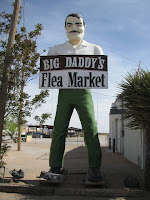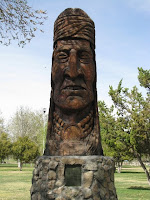 Our first stop before departing Carlsbad on Tuesday morning, 29MAR, was at a Exxon station closed for remodeling. Turns out that you could still purchase diesel by paying with a credit card at the pump; & we are guessing that since they did not have to pay any employees, their price was ten to fifteen cents a gallon cheaper than any other station. Rather than drive on I-10 west through El Paso, TX, to get to Las Cruces, NM, Dan decided to go north on a secondary road via Cloudcroft. The last portion of this route is very steep & curvy with many warning signs for truckers about the steep grade; in fact our next door fellow RV’er couldn’t believe we were taking that route. End result was that it was a very scenic drive, with the last fifteen miles a bit of a challenge (but we have driven worse) & we avoided the “madness” of I-10 through El Paso. We set up camp & headed to the village of Mesilla for dinner.
Our first stop before departing Carlsbad on Tuesday morning, 29MAR, was at a Exxon station closed for remodeling. Turns out that you could still purchase diesel by paying with a credit card at the pump; & we are guessing that since they did not have to pay any employees, their price was ten to fifteen cents a gallon cheaper than any other station. Rather than drive on I-10 west through El Paso, TX, to get to Las Cruces, NM, Dan decided to go north on a secondary road via Cloudcroft. The last portion of this route is very steep & curvy with many warning signs for truckers about the steep grade; in fact our next door fellow RV’er couldn’t believe we were taking that route. End result was that it was a very scenic drive, with the last fifteen miles a bit of a challenge (but we have driven worse) & we avoided the “madness” of I-10 through El Paso. We set up camp & headed to the village of Mesilla for dinner. We have visited Mesilla a few times already. The first time was back in 2005 when we met Dan’s sister, Sharon, & hubby, Tim Tompkins, there in our old gas RV, & spent a few days exploring. The last visit was almost a year ago (see below BLOG link) when we were El Paso for over a week. Mesilla has been a historic town as a part of Mexico & later as part of the USA as a result of the Gadsden Purchase. At one time it was the territorial capitol of Arizona & New Mexico. The town of Las Cruces would not be the second biggest city in NM if the citizens of Mesilla had not declined the railroads offer to run through their town. End result of their decision was the train line went to Las Cruces & Mesilla turned into a sleepy little village, surrounded by the ever growing Las Cruces. We had dinner at La Posta an establishment we had walked by before on previous visits. Apparently it is one of those must do things for tourists & we always saw people waiting to get in. We got their early & avoided the crowds. We found the food no better than most TexMex restaurants, but Dan enjoyed their Chili Rita. 




Wednesday morning, Dan headed to the White Sands Missile Range Museum & Missile Park. The museum is being reorganized & most of the video equipment was not functioning, but Dan still found it fascinating. In addition to missile “history”, the museum also had displays on Mimbres pottery, early settlers, Bataan Death March Buffalo Soldiers, NASA, Victorio War, & other non-missile topics. About the Victorio War one 2nd LT Finley wrote – “It is the old story, unjust treatment of the Indians by the Govt., treaties broken, promises violated and the Indians moved from one reservation to another against their will, until finally they break out and go on the war path and the Army is called in to kill them. It is hard to fight against and shoot down men when you know they are in the right and are really doing what our fathers did in the Revolution, fighting for their country.”
Upon viewing the Bataan Death March display, it reminded Dan that we had seen Memorials to the event in many NM towns & we had even driven on the Bataan Memorial Highway. There is even a Bataan marathon on the missile range each year. Now he wondered why this tragic event was so significant to NM? Turns out that one of the largest USA units in the Philippines at the start of WWII, was the 200th Coast Artillery from New Mexico. They had been sent to the Philippines because many of them spoke Spanish. They held the Japanese off for four months with inferior weapons & no food before surrendering & then enduring the infamous march. By the end of the war NM had the most per-capita casualties of any state, & only half her men came home!
Another display was of an original German V2 rocket. This is a stand alone exhibit in its own building with a very detailed description of the German development program; along with details of the USA’s “race” to beat the Russians in seizing as many German scientists & V2 actual components before the war ended. The scientists were easy, since many of them fled to the west into the arms of the USA Army rather than be captured by the Russians. The Americans discovered a V2 factory in Nordhausen, Germany, an area that was to be handed over to the USSR. The Army quickly removed everything & shipped it west. The end result is in August of 1945, 300 railroad cars of V2 “stuff” showed up in Las Cruces, New Mexico, & every railroad siding for 210 miles was used to hold the freight cars. It took another 30 days to bring everything to the newly created White Sands Proving Ground (original name).
Trivia – more V2s were fired at targets on the continent of Europe than at the UK, what city was the primary target of 1,780 of these rockets (think diamonds)?
One of the most interesting “displays” was a photo album put together in 1999. It contained photos taken by a young Army enlisted man who was stationed at a very remote facility of the missile range sometime in late 50s or early 60s? The person that put the album together also penned some words about his recollection of what was occurring in each photo. To Dan it reminded him experiences of countless young men in the military - trying to keep their cars running with little or no money, chasing women, trying to fool the sergeants & officers, using their last dollars for beer & cigarettes, trying to sleep during duty hours, etc; while enduring the pettiness of military regulations & countless hours of boredom. One quote was about a rare party with women from the Womens Army Corps (WACs) - “Most of the women were wilder than the antelope.”




 Trivia – how did the Army locate missile parts in the remote desert after test firing (think squalene)?
Trivia – how did the Army locate missile parts in the remote desert after test firing (think squalene)?After Dan rejoined Corrie, it was off to explore the eccentric roadside attractions in Las Cruces. We discovered an armless Muffler Man, El Toro the Bull w/his blue balls, & a giant Geronimo statue by Peter Toth. For some reason Mr Toth started carving monumental statues in honor of Native Americans in 1972, & decided to place one in every state in the USA! Some states have more than one, & some of the statues have since “disappeared”. According to his below website, there are 55 statues in the USA & 2 in Canada. Something else for Dan to seek out on our RV journey!

 http://www.dcschumaker.com/ http://www.dcschumaker.com/statues.htm
http://www.dcschumaker.com/ http://www.dcschumaker.com/statues.htm


 http://www.dcschumaker.com/ http://www.dcschumaker.com/statues.htm
http://www.dcschumaker.com/ http://www.dcschumaker.com/statues.htm Thursday morning, 31MAR, we had hoped to accomplish two “chores” & then hit the road toward the Gila Wilderness Area & the town of Silver City, NM. First thing to accomplish was having our TV antenna system checked out to determine way we can no longer receive the over-the-air digital TV transmissions we used to get? For those of you who receive your TV via cable or phone lines, you may not see the necessity of an old fashioned antenna. When the federal gov’t mandated all broadcast stations switch to a digital transmission it cost the stations money to make the shift, but the stations also received a benefit – instead of one frequency to transmit on, they now can have multiple channels showing different shows at the same time! For example, channel 4 in Las Cruces is now 4-1, 4-2, 4-3 & 4-4; all with different shows being broadcast at the same time.
In addition, we have found that that the cable in RV parks is often not digital quality, let alone HDTV. But the over the air broadcasts by law must be digital, & often are true HDTV. So in cities with ABC, NBC, CBS, Fox, PBS, Univision, etc, we should get fifteen to thirty or more digital broadcast stations. However, starting about three months ago we noticed that we could only pick up two or three stations, & often none. Dan changed out several components of the system with no luck & finally determined the problem was in the RV roof between the antenna & the 12 volt booster. So we made an appointment at Camping World of El Paso to troubleshoot & fix. Joe the technician disassembled the antenna & determined that one of the fittings in the roof was rusted beyond repair – problem solved.
Second item on the “to do” list was pick up our mail being forwarded to us from Texas. Unfortunately, it did not arrive, so it was back to the RV park we had just checked out of this morning for another night in Las Cruces.
Friday morning rather than wait around for the mail Dan headed to the New Mexico Farm & Ranch Heritage Museum. This is an excellent museum obviously depicting farm & ranch heritage in the Las Cruces area; but also had two unique displays – the history of the postcard in the USA, & a display about the Dust Bowl. Dan learned that the postcard was an Austrian invention in 1869, & was first issued by the US Post Office in 1873. Postcards in the USA remained a government monopoly until 1901, & it was illegal to write on the back side of the card, forcing people to write their message on the artwork on the front until 1907. Dan was surprised to learn the “dust bowl” was an event that lasted several years, & that the storms on rare occasion reached the west or east coast! In fact, one storm even reached Washington DC, on 21 March 1935, one week before Congressional Hearings on the matter. A dust bowl joke at the time was – “I hope it’ll rain before the kids grow up. They ain’t never seen none.”
While at the museum Dan also learned that the state is promoting a Green Chile Cheesburger Trail, apparently because green chile cheeseburgers have been getting a lot of play on TV food networks. All too soon Corrie called Dan & told him it was time to check the mail, so Dan had to cut it short & head back to the RV.











No comments:
Post a Comment